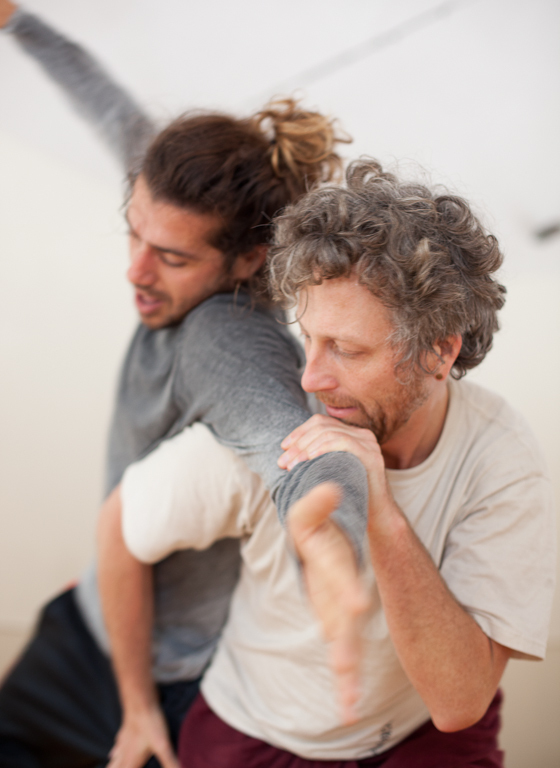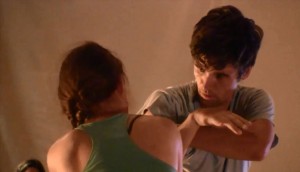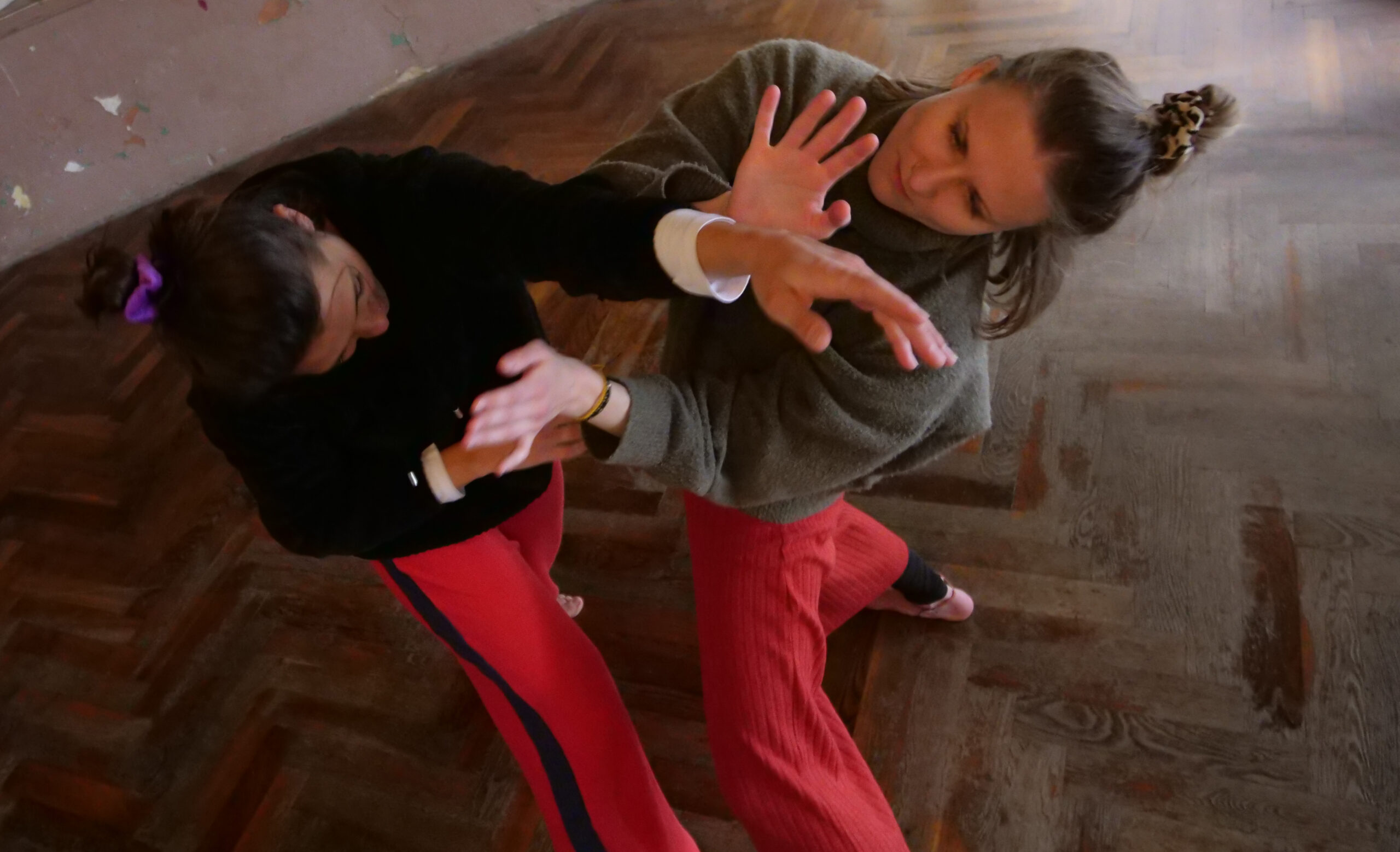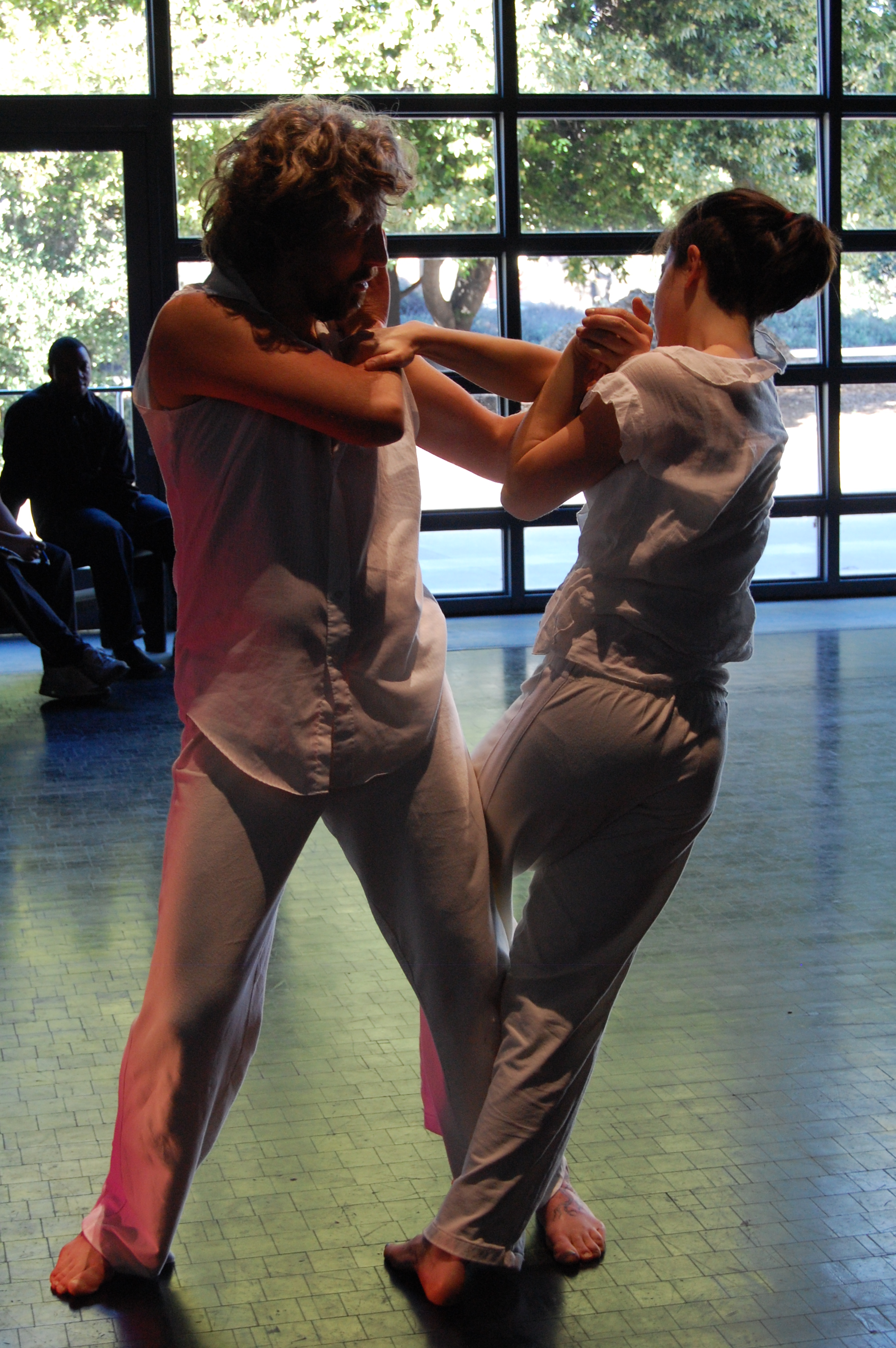Martial Dance
Martial Dance is a contact play and sensory study framework developed out of the explorations of a group of dancer/martial artists in California in the early 1990s. It’s foundation is the playful touch practice of Toishou (“push hands”) from the Chinese Daoist martial arts (eg. Tai Chi, Ba Gua Zhang, etc) … somewhere between a gentle sparring practice and sensory meditation on physical listening, body mechanics, and complex adaptive alignment and dance. We touch, we listen through touch, we perceive ourselves in mechanical relationship, and play with adapting that relationship while our partner does the same. We participate in shaping our partner’s movement while our partner does the same with us. Following curiosity and a sense of play, we oscillate between playful mutual challenge and pure following/adapting/sensing. We expand 3 dimensionally on traditional push hands work through taking movement into and out of the floor and through the air with supports and lifts (a gentler take on “throws”)
 The basic premise of the frame is to practice self awareness, continuous physical listening, keeping healthy physical integrity in dynamic contexts, studying relationship of intention to dysfunctional attachment (hyper reactivity and evacuation), practicing awareness of the fundamental reality of lack of control in which we have influence over events, but never control of them. The martial side of the work gives a kind of “testing framework” that more rigorously and sensitively challenges us to develop as aware humans. We cultivate physical listening to our own and our partner’s structures and weight, accepting the inevitable influence from the other that comes with physical contact as we play with directing, accepting direction, and redirection. We play with mutual manipulation and influence, adapting to circumstances.
The basic premise of the frame is to practice self awareness, continuous physical listening, keeping healthy physical integrity in dynamic contexts, studying relationship of intention to dysfunctional attachment (hyper reactivity and evacuation), practicing awareness of the fundamental reality of lack of control in which we have influence over events, but never control of them. The martial side of the work gives a kind of “testing framework” that more rigorously and sensitively challenges us to develop as aware humans. We cultivate physical listening to our own and our partner’s structures and weight, accepting the inevitable influence from the other that comes with physical contact as we play with directing, accepting direction, and redirection. We play with mutual manipulation and influence, adapting to circumstances.
The fully developed framework is very open, with a modulation of intention narrowness and attachment in a context of adaptive physical listening (as a dynamic physical activity as opposed to some sort of theoretical receptive non-action). We play in contact with each other, working with more or less specific intentions held with more or less attachment, where intentions have to do with movement relative to each other and manipulation of each other. In one moment, we simply listening to the other’s structure in motion. In another, we carry a more or less specific intention in relation to another’s movement or our own movement. We study the affects of intention on reactivity, working to be gradually less reactive. (here, “reactive” is understood in the same technical sense as in the passive sequencing work.)
The training sequence to develop this frame usually includes the following steps. They accumulate, so, for example, the release of Cloud Arms continues into Sticking Cloud Arms.
The end purpose is to be able access to a more 3 dimensionally articulate availability for interaction, with physical safety and soft power, so we can interact in a wider variety of ways with different bodies.
Some initial elements and stages…
- Cloud Arms Study: floating the arms slowly through space, keeping the elbows and shoulders dropped (releasing excess tension), self studying the mechanics of shoulder socket and sterno-clavicular joints in relation to arms. Expand from here to spinal movement (especially twisting motion), then to shifting weight from foot to foot, then to floating a leg up and articulation independently of standing and floating leg hip sockets, all in relation to the movement of the arms through space. Note that the rotation of the floating leg’s hip joint moves the leg; rotation of the standing leg’s hip joint moves the body. This walks through the space with the emptying and filling of the legs and the articulation of the hip sockets. Throughout, there is a scanning for movement glitches and arising tension, minimizing excess tension, and allowing breath to be unrestricted by gripping of spinal muscles or other forms of reaction. This is related very much to explorations of Tai Chi/Ba Gua, Alexander Technique, Feldenkrais, etc.
- Sticking Listening Cloud Arms: two partners connect their arms around the wrist and follow very immediately and quietly any subtle shifts in pressure, each arm independently. Stick to the other and follow any subtle push, yield, or lateral motion. The body is continuously reorganized to keep as easy as possible while sticking: feet move where they need to, arms stay relaxed and within peripheral vision, elbows stay dropped, etc.. If attention gets riveted in one arm. Switch attention to the other arm, attempt to alternate, then attempt to hold full attention in both arms at the same time. After the exercise is established, try subtly to proprioceptively feel through the contact the partner’s structure, to their feet and skull. This will inevitably involve a certain amount of probing pressure, but one tries to minimize these probing forces, using the minimum necessary or using only incidentally occurring pressure shifts to feel through the partner’s structure. Our sense of proprioception works through interaction and shifting pressure. One needs to interact in order to sense. However, this interaction can be quite small; one only needs grams of shifting pressure to feel the partner’s entire muscular/skeletal structure. The trick then, is that while it is necessary to come into interaction in order to sense, one tries to keep the force of interaction as slight as possible.
 Center Line: A simple game used to orient onto an evading partner and evade while orienting.
Center Line: A simple game used to orient onto an evading partner and evade while orienting.
I want to touch my partner’s center line.
I don’t want my partner to touch my center line.
I want to move no faster than my partner or even move a little slower.
I want to use less muscular effort than my partner, relying instead on movement intelligence, density of awareness, and skeletal structure.
When contact is made, hold it as long as you can (staying slow and soft), as opposed to “tag and withdraw”. This allows your partner to work out how to evade, and it also keeps your mind n ongoing process rather than fixating on moments.
This is primarily a study in reactivity… we tend to get hyper attached right when we are about to touch or be touched, blacking out at this point and initiating blind reactions. This is what we are looking to find, to breathe through. We maintain intention without losing presence.- Circle Game: I stand near my partner and imagine a circle around us, with my partner at the center. My partner does the same. Our circles are in our own minds and are different. We do not communicate them to each other. I want to move my partner outside of the circle, and I want to stay inside the circle. I want to move slowly and no faster than my partner. I want to stay soft, pliable, and present, and use less muscular effort than my partner. When I succeed in moving my partner out or am pushed out, I simply start over again with a new imagined circle without interrupting our connection. This game can be expanded to include putting my partner on the ground and avoiding being put on the ground.
- Open Circle Play: We start with Sticking Cloud Arms. At any point I or my partner switches to Circle Game. We switch back and forth whenever we want. We might both be in the same score or in opposite scores. Note: Cloud Arms is NOT passive. It is an active listening, constant rearrangement of the body into easeful integrity, unconcerned with the goals of the circle game. Note: best not to switch games at convenience moments … this can itself be a form of reactivity. For example, if I am playing the circle game and am about to loose (or win), do not switch at this moment to sticky arms. Stick with it through awkward moments. As a martial training, it is an excellent training in staying non reactive through vulnerable moments so we can act with more intelligence under pressure.
